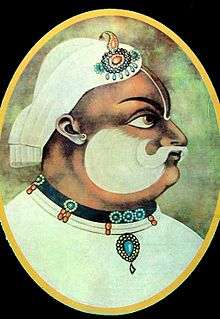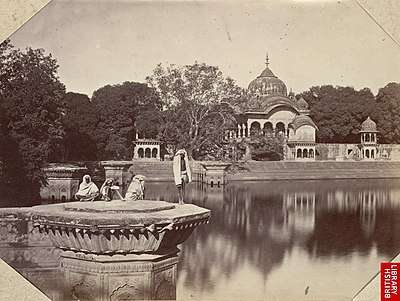Suraj Mal
Maharaja Suraj Mal (February 1707 – 25 December 1763) or Sujan Singh was a Hindu Jat ruler of Bharatpur in Rajasthan, India. Under him, the Jat rule covered the present-day districts of Agra, Aligarh, Bharatpur, Dholpur, Etawa, Gurgaon, Hathras, Mainpuri, Mathura, Mewat, Meerut, Rewari, and Rohtak.[2]
| Suraj Mal | |
|---|---|
| Maharaja of Bharatpur Bahadur Jung | |
 Maharaja Suraj Mal | |
| Reign | r. 1755 – 1763 AD |
| Coronation | Deeg, 23 May 1755 |
| Predecessor | Badan Singh |
| Successor | Jawahar Singh |
| Born | February 1707 |
| Died | 25 December 1763 (aged 56) near Delhi |
| Wives | Maharani Kishori Rani Gauri of the Gori clan[1] |
| Issue | Jawahar Singh Nahar Singh Ratan Singh Nawal Singh Ranjit Singh |
| House | Sinsinwar Dynasty |
A contemporary historian had described him as "the Plato of the Jat tribe" and by a modern writer as the "Jat Odysseus", because of his "political sagacity, steady intellect and clear vision".[3] The Jats, under Suraj Mal, overran the Mughal garrison at Agra. Suraj Mal was killed in an ambush by the Mughal Army on the night of 25 December 1763 near Hindon River, Shahadra, Delhi. In addition to the troops stationed at his forts, he had an army of 25,000 infantry and 15,000 cavalry when he died.[2]

Battle of Kumher
Mughal Emperor Alamgir II and his rebellious courtier Siraj ud-Daulah were having a factional feud. Suraj Mal had sided with Siraj. Alamgir sought the help of the Holkar Marathas of Indore. Khanderao Holkar, son of the Maharaja of Indore, Malhar Rao Holkar, laid a siege on Suraj Mal's Kumher in 1754. While inspecting the troops on an open palanquin in the battle of Kumher, Khanderao was hit and killed by a cannonball from the Bharatpur army. The siege was lifted and a treaty was signed between Jats and Marathas, which later proved helpful for Suraj Mal in consolidating his rule.[4][5]
Legacy
His large cenotaph is at Kusum Sarovar, Govardhan, Uttar Pradesh.[6] His imposing chattri is flanked on either side by two smaller chattris of his two wives, "Maharani Hansiya" and "Maharani Kishori".[7] These memorial chattris were built by his son and successor Maharaja Jawahar Singh. The architecture and carving is in the pierced stone style and the ceiling of cenotaphs are adorned with paintings of the life of Krishna and Suraj Mal.[7] His court poet Sūdan recorded his biography in Sujān Charitra.
Notable institutes named after him include Maharaja Surajmal Institute of Technology and Maharaja Surajmal Brij University, Bharatpur.
References
- Dwivedi, Girish Chandra; Prasad, Ishwari (1989). The Jats, their role in the Mughal Empire. Arnold Publishers. p. 238. ISBN 978-81-7031-150-8.
- Chaudhuri, J. N. (1977). "Disruption of the Mughal Empire: The Jats". In Majumdar, R. C. (ed.). The History and Culture of the Indian People. Vol. 8: The Maratha Supremacy. Bharatiya Vidya Bhavan. p. 157. OCLC 1067771105. Retrieved 20 December 2019.
- R.C.Majumdar, H.C.Raychaudhury, Kalikaranjan Datta: An Advanced History of India, fourth edition, 1978, ISBN 0-333-90298-X, Page-535
- Advanced Study in the History of Modern India 1707-1813, by Jaswant Lal Mehta, pp606
- Images of Women in Maharashtrian Literature and Religion, edited by Anne Feldhaus, pp185-186
- Cenotaph of Raja Sooruj Mull, Govurdhun. 97140, British Library online collection
- D. Anand, 1992, Krishna: The Living God of Braj, Page 56.
Suraj Mal Sinsiniwar Jat Dynasty Born: 1707 Died: 1763 | ||
| Regnal titles | ||
|---|---|---|
| Preceded by Badan Singh |
Maharaja of Bharatpur 1755–1763 AD |
Succeeded by Maharaja Jawahar Singh |